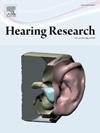Musically evoked emotions in cochlear implant users and those with no known hearing loss
IF 2.5
2区 医学
Q1 AUDIOLOGY & SPEECH-LANGUAGE PATHOLOGY
引用次数: 0
Abstract
Background
Cochlear implants provide the profoundly deaf excellent speech comprehension; however, perception and appreciation of music remains a challenge. Previous work suggests that cochlear implant users, compared to normal-hearing listeners, have diminished perception of certain musically evoked emotions due to deficits in hearing pitch-related musical elements. The purpose of this study was to investigate how well cochlear implants users use pitch-based information to identify the emotional intent of music.
Methods
Twenty-six cochlear implant users and 24 peers with no known hearing loss completed a set of online auditory measures. Participants were asked to rate the valence and arousal of 10 happy, 10 sad, 10 scary, and 10 peaceful melodies as categorized by Vieillard et al. (2008). Melodies that were previously categorized as peaceful and sad were then altered from major to minor modes (peaceful to peaceful-modified) and from minor to major (sad to sad-modified), respectively. Additionally, the tempo of these melodies was controlled at 60 beats per minute. Participants then valence and arousal of these 10 sad, 10 sad-modified, 10 peaceful, and 10 peaceful-modified melodies. Participants completed a series pitch perception tasks including major and minor melody and arpeggio discrimination and melodic contour identification. During data analysis, correlations between valence and arousal ratings, major and minor melody and arpeggio discrimination scores, and melodic contour identification scores were assessed.
Results
When listening to the unmodified melodies from Viellaird et al. (2008), both cochlear implant users and those with no known hearing loss rated happy melodies more distinctly in valence and arousal than sad, peaceful, and scary melodies. Cochlear implant users rated the valence of sad and peaceful melodies more similarly compared to those with no known hearing loss. When listening to the modified melodies, cochlear implant users rated original and modified sad and peaceful melodies similarly on the dimensions of valence and arousal. This contrasts with results found in those with no known hearing loss who utilized mode changes to rate melodies in major modes higher in valence than melodies in minor modes. For major and minor melody and arpeggio discrimination, those with no known hearing loss performed close to or at ceiling while cochlear implant users mostly performed in the chance range. Finally, for melodic contour identification, many cochlear implant users performed significantly worse than those with no known hearing loss.
Conclusion
This study further reveals the challenges that cochlear implant patients face in using modal cues to perceive the emotional intent of music. While cochlear implant users are able to utilize tempo cues to derive the emotional intent of melodies to an extent, they struggle once these cues are taken away. Therefore, the data presented here provides a foundation upon which to explore how pitch-based training may improve cochlear implant users’ perception of musical mode. Given the ubiquity of using mode to communicate musical emotional intent, pitch-based training may in turn lead to enhanced music appreciation among cochlear implant users.
音乐能唤起人工耳蜗使用者和无听力损失者的情绪
人工耳蜗为重度聋人提供了良好的言语理解能力;然而,感知和欣赏音乐仍然是一个挑战。先前的研究表明,与听力正常的听者相比,人工耳蜗使用者对某些音乐唤起的情绪的感知能力下降,这是由于他们听不到与音高相关的音乐元素。本研究的目的是调查人工耳蜗使用者如何利用音高信息来识别音乐的情感意图。方法对26名人工耳蜗使用者和24名无听力损失的同龄人进行在线听力测试。参与者被要求对10种快乐、10种悲伤、10种恐惧和10种平静的旋律的效价和唤醒度进行评分,这些旋律是由Vieillard等人(2008)分类的。之前被归类为平和和悲伤的旋律,然后分别从大调调到小调调(平和调到平和调)和从小调调到大调调(悲伤调到悲伤调)。此外,这些旋律的节奏被控制在每分钟60次。然后参与者对这10个悲伤的、10个悲伤修饰的、10个平和的和10个平和修饰的旋律的效价和唤醒。参与者完成了一系列音高感知任务,包括大调、小调、琶音辨别和旋律轮廓识别。在数据分析过程中,评估了效价和唤醒评分、大调和小调旋律和琶音辨别得分以及旋律轮廓识别得分之间的相关性。结果当听Viellaird et al.(2008)的未经修饰的旋律时,人工耳蜗使用者和那些没有听力损失的人对快乐旋律的效价和唤起的评价都比悲伤、和平和恐怖的旋律更明显。与没有听力损失的人相比,人工耳蜗使用者对悲伤和平静旋律的评价更为相似。当听改良的旋律时,人工耳蜗使用者在效价和唤醒的维度上对原始和改良的悲伤和和平旋律的评价相似。这与那些没有听力损失的人的结果形成对比,他们利用调式变化来评价大调调式旋律的效价高于小调调式旋律的效价。对于大调、小调和琶音的辨别,那些没有听力损失的人的表现接近或接近上限,而人工耳蜗使用者的表现大多在机会范围内。最后,对于旋律轮廓识别,许多人工耳蜗使用者的表现明显比没有听力损失的人差。结论本研究进一步揭示了人工耳蜗患者在使用情态线索感知音乐情感意图时所面临的挑战。虽然人工耳蜗使用者能够利用节奏线索在一定程度上推导出旋律的情感意图,但一旦这些线索被拿走,他们就会陷入困境。因此,本文提供的数据为探索基于音高的训练如何提高人工耳蜗使用者对音乐模式的感知提供了基础。鉴于使用模式来交流音乐情感意图的普遍存在,基于音高的训练可能反过来导致人工耳蜗使用者增强音乐鉴赏力。
本文章由计算机程序翻译,如有差异,请以英文原文为准。
求助全文
约1分钟内获得全文
求助全文
来源期刊

Hearing Research
医学-耳鼻喉科学
CiteScore
5.30
自引率
14.30%
发文量
163
审稿时长
75 days
期刊介绍:
The aim of the journal is to provide a forum for papers concerned with basic peripheral and central auditory mechanisms. Emphasis is on experimental and clinical studies, but theoretical and methodological papers will also be considered. The journal publishes original research papers, review and mini- review articles, rapid communications, method/protocol and perspective articles.
Papers submitted should deal with auditory anatomy, physiology, psychophysics, imaging, modeling and behavioural studies in animals and humans, as well as hearing aids and cochlear implants. Papers dealing with the vestibular system are also considered for publication. Papers on comparative aspects of hearing and on effects of drugs and environmental contaminants on hearing function will also be considered. Clinical papers will be accepted when they contribute to the understanding of normal and pathological hearing functions.
 求助内容:
求助内容: 应助结果提醒方式:
应助结果提醒方式:


